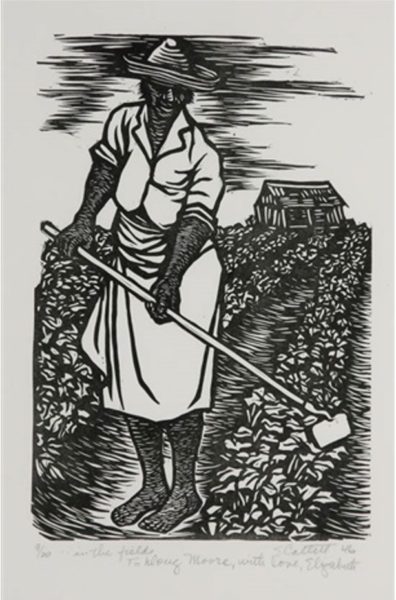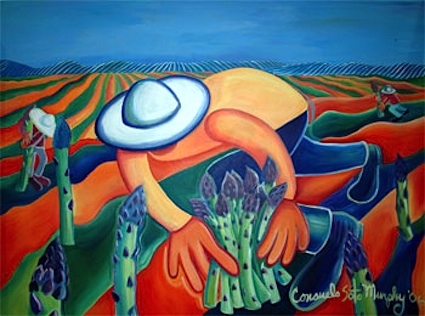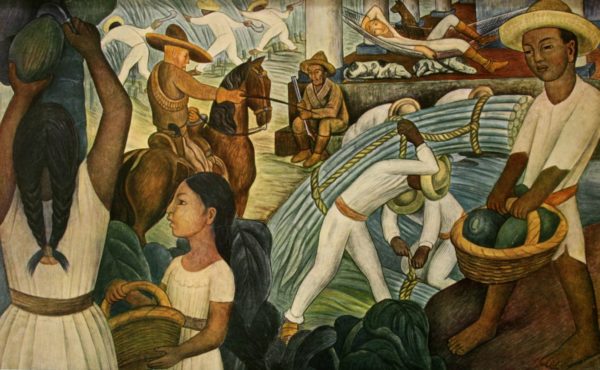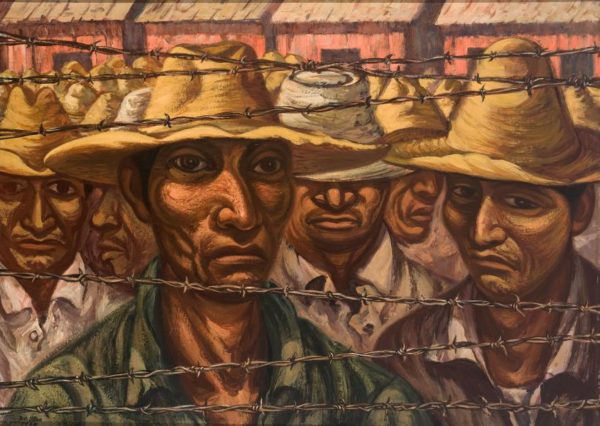Here is a scene of violence and inhumanity that feels torn from the front page of the newspaper or a report on the latest immigration raid outrage. But this is the kind of news that stays news because it keeps happening.
Bent to the Earth
would have to stop. Ruben spun
trying to show them our green cards.
and was free. There were no great truths
by Blas Manuel De Luna
Looking for images to put beside the poem I thought of Elizabeth Catlett whose linocuts, lithographs and oil paintings are such powerful tributes to backbreaking labor. At the University of Iowa she studied with Grant Wood who advised her to paint what she knew the most about. Catlett considered that she knew the most about being a black woman and her work focusses primarily – but not exclusively – on images of black women. Catlett grew up in Washington D.C. but – after visiting Mexico in 1946-7 on a foundation grant – she established permanent residency there in 1947.


We know the deprivations that exist in the black community and how mental and emotional frustrations lead to wasted lives. If we can enrich the life of one black man woman or child then we have fulfilled our function as art producers. Artists are the sensitive area of the community and can clarify so many things. We can project the beauty of our people, the grace, the rhythm, the dignity. We can explain frustrations and stimulate joy. The artist must be an integral part of the totality of black people.
Elizabeth Catlett quoted in an article by Samella Lewis in the IRAAA journal (then called Black Art) in Fall 1976 that focused on Catlett’s humanitarian spirit.


Diego Rivera depicts a different kind of violence and injustice in this scene of agrarian class struggle where shades of skin color define the roles. There are those that do the work. There are those that supervise the work. And then there are those who enjoy the fruits of all that labor. There are those that harvest papayas and cut and bear the burden of the sugar cane. There’s a foreman on horseback and a landowner lazing in a hammock.
And finally Braceros by Domingo Ulloa. A bracero was a Mexican laborer allowed into the US for a limited time as a seasonal agricultural worker. Literally it means one who swings his arms. The bracero program (1942-1964) provided temporary contract workers from Mexico to meet agricultural labor shortages caused in part by the internment of Japanese tenant farmers. Ulloa drew on his visits to a bracero camp in San Diego County for this painting of faces separated from us by a barbed wire fence. And of course it brings to mind the images of Nazi concentration camps.

Domingo Ulloa
(1919 – 1997)
Featured image: “Suenos Humedos” (“Wet Dreams”) by Juan Carlos Marcias.



This is such a moving Post. Terrible casual cruelties with families split apart.
The pictures add an extra layer to the story.
Gwen.
I hope you tag or bookmark your poetry month posts so we can all come back to them at will. Every one of them is worth not only reading but re-reading.